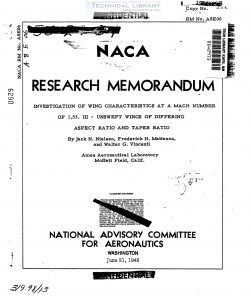naca-rm-a8e06
- Version
- 61 Downloads
- 1.99 MB File Size
- 1 File Count
- April 20, 2017 Create Date
- April 20, 2017 Last Updated
National Advisory Committee for Aeronautics, Research Memorandum - Investigation of Wing Characteristics at a Mach Number of 1.53. III - Unswept Wings of Differing Aspect Ratio and Taper Ratio

As the third part of a general study of wing characteristics at
supersonic speed, wind—tunnel tests were conducted of seven models
forming two series of wings: (l) a series of taper ratio 0.5 and
differing aspect ratio and (2) a series of aspect ratio A and differ—
ing taper ratio. All wings had an isosceles—triangle airfoil section
5—percent—thick and an unswept midohord line. Measurements were made
of lift, drag, and pitching moment at a Mach number of 1.53 and a
Reynolds number of O. 75 million. The experimental results were
analyzed and compared with the characteristics calculated by means of
linear theory.
The aerodynamic parameters generally varied with aspect ratio and
taper ratio in the manner indicated by the linear theory. The maJority
of the aerodynamic parameters showed considerable variation with aspect
ratio in the low—aspect—ratio range only. The parameters showed no
appreciable change with taper ratio for the aspect ratio of h. (This
does not preclude the possibility of appreciable taperaratio effects
at lower aspect ratios.)
The measured values of the lift—curve slope were in close accord
with the theoretical values for all the wings, but the experimental ‘
angles of zero lift were consistently higher than those given by
linear theory mainly because of higher—order pressure effects neglected
in linear theory. Both lift-curve slepe and angle of zero lift
increased with increase in aspect ratio.
The experimental values of momenthcurve slope indicated positions
of the aerodynamic center forward of those given by theory because of
higher—order pressure effects and boundary—layer,shock—wave inter—
action near the trailing edge. The measured moment coefficients
at zero lift were in good accord with the negative values calculated
by linear theory. The aerodynamic center moved forward significantly
with decrease in aspect ratio.
The drag curves were closely parabolic. The minimum drag
increased slightly with increase in aspect ratio, and the drag—rise
factor decreased. No decisive comparison could be made between
experiment and theory for minimum drag because of the large but
undetermined effects of support—body interference and skin friction
upon this parameter. Rounding the leading edge of a rectangular
wing of aspect ratio 4 to a radius of 0.25 percent of the chord
increased the minimum drag coefficient by about 27 percent, but had
no measurable effect on the lift and moment characteristics.
| File | Action |
|---|---|
| naca-rm-a8e06 Investigation of Wing Characteristics at a Mach Number of 1.53. III - Unswept Wings of Differing Aspect Ratio and Taper Ratio.pdf | Download |

Comment On This Post